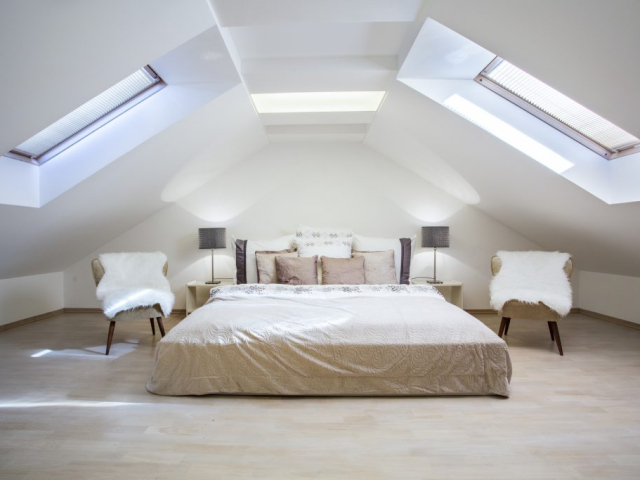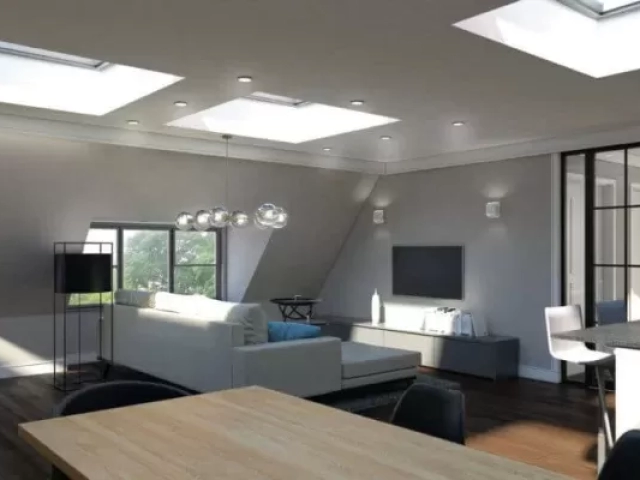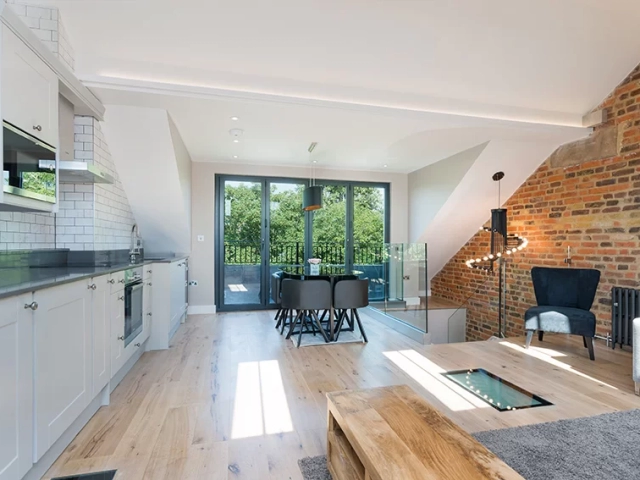
What Is A Loft Conversion?
Simply put, a loft conversion transforms an underutilised attic space into a habitable and functional area within a home. This renovation project can vary in complexity, from adding a few skylights to undertaking a complete structural change.
The result is an increase in the usable square footage of the property, which not only provides more room for the homeowners but also has the potential to significantly enhance the property’s market value.
Historically, the attic of a house was considered a storage area, filled with boxes and forgotten items. However, with modern design advancements and a shift towards maximising space, the humble attic has gained a new lease on life.
Our team here at Detailed Planning have been offering loft conversions by professional architects in South London, East London, West London and North London for several years; during this time, we have perfected our skills and can now offer what we think is the highest quality loft conversion service across London!
Before We Get Started – What Is A Loft In A House?
It might sound like an obvious answer, but a loft is an open or enclosed space directly under the roof. Lofts are often used for storage, living areas, or bedrooms. They are typically characterised by high ceilings, exposed beams, and unique architectural features, making them popular in modern and industrial-style homes.
They can be converted into functional spaces like home offices, playrooms, or guest bedrooms, adding value and versatility to a property. Whether considering a loft conversion or wondering about its potential uses, a loft can transform underutilised space into a practical and stylish part of your home.
Lofts are also ideal for bringing in natural light, creating an airy and open ambience. Whether renovating an older home or designing a new one, incorporating a loft can add significant value and versatility to your property.
Moreover, a well-designed loft can become a focal point of the home, blending practicality with style and providing a creative solution for underutilised spaces. Let us examine loft conversions in more detail! If you have any questions, give our team a shout; we are happy to help!
The Growing Trend of Loft Conversions
The trend of loft conversions has significantly increased in recent years, driven by the desire for more living space without the substantial cost of moving. As housing prices continue to rise and the need for flexible living arrangements becomes more prevalent, homeowners are looking upward—towards the untapped potential of their lofts.
The beauty of converting a loft is that it adds square footage to the home and adapts to many uses, from serene bedrooms to dynamic workspaces. This practical solution has become a buzzword in home improvement circles, with its ability to offer both aesthetic appeal and functionality while also being a savvy investment strategy.
The loft conversion trend also mirrors the shift in lifestyle where remote work is now commonplace, necessitating dedicated and tranquil home office spaces. Moreover, this upward expansion is often more sustainable, circumventing the need to build outwards and preserve precious garden space, which aligns with the growing eco-conscious mindset among homeowners.
With such versatility and financial allure, it’s no wonder that loft conversions have climbed to the top of the list for modern home renovations. Paired with the abilities of architectural designers, you can benefit from a loft conversion that will not only provide practicality, but it will also provide you with design elements you are dreaming of!
Understanding the Basics of Loft Conversions
At the core of a loft conversion lies the principle of transforming unused or underutilised attic space into a functional area accessible and comfortable for living. Understanding the basics of a loft conversion starts with recognising the potential of the existing space and envisioning its transformation.
A typical loft conversion involves reinforcing the floor, adding windows, and insulating the walls to create a room that’s as cosy and inviting as any other in the house. But it’s not just about adding space; it’s about optimising it with intelligent design choices to suit specific needs, whether an extra bedroom, a home office, or a recreational area.
Factors such as the type of roof, the available head height, and the structure of the existing property play crucial roles in determining the feasibility and type of conversion suitable for a home.
Additionally, understanding the requirements for planning permission, the need for building regulations approval, and the different types of conversions—such as dormer, mansard, hip-to-gable, and Velux—are fundamental to laying the groundwork for a successful project.
By grasping these basics, homeowners can proceed with a loft conversion that meets their needs and adheres to legal and safety standards, ensuring a worthwhile addition to their living space.
What Is Involved In A Loft Conversion?
A loft conversion involves converting the unused attic space into a liveable and functional room tailored to the homeowner’s requirements. The project typically begins with a thorough assessment of the loft’s structure to ensure it can support the additional weight and usage.
Critical structural work often includes reinforcing the floor joists, modifying the roof structure for headroom, and installing appropriate insulation to meet building regulations. Windows or skylights are fitted to provide natural light, often necessitating dormers or other extensions to the existing roof line.
Staircases must be added or adapted to allow safe and easy access. Installing electrical, heating, and plumbing systems is integral, notably, if the space includes a bathroom. Interior finishing touches such as drywall, flooring, and lighting transform the area from a storage zone into a cohesive part of the home.
Each stage of loft conversion requires meticulous planning, design, and construction work, often involving architects, structural engineers, and specialised builders to navigate the project from concept to completion while complying with local building codes and regulations.
Planning Your Loft Conversion
Planning your loft conversion is a critical step that sets the foundation for successfully transforming your attic space. It starts with assessing the loft to ensure it’s suitable for conversion, considering factors like the available headroom, roof pitch, and the overall structural integrity of the building.
Engaging with an architect or surveyor can provide valuable insights into your space’s design possibilities and limitations. Once the feasibility is confirmed, understanding and adhering to local building regulations and planning permissions is paramount to ensure the conversion is legal and safe. It’s also essential to have a clear budget that accounts for all aspects of the conversion, from construction to interior finishes.
Selecting the right contractor is another crucial element; they should have a strong portfolio of completed loft conversions, a transparent communication style, and solid references.
This stage is about foresight and meticulous organisation, ensuring that every detail, from the placement of windows to the type of insulation, is planned out before any construction begins to help guarantee a smooth and efficient conversion process.
Design Considerations
When delving into the design aspects of a loft conversion, there are multiple considerations to ensure that the new space is aesthetically pleasing but also practical and cohesive with the rest of the home. The design must consider the attic’s natural structure, utilising sloping ceilings and natural light to enhance the room’s ambience.
Decisions on window placement, such as installing skylights or dormer windows, will significantly impact the light and feel of the room. Choosing how to integrate storage solutions into eaves and recesses can maximise space efficiency without compromising on the sleekness of the design.
It’s also important to consider the loft’s intended use when making design choices; a bedroom may require a different layout and features than a home office or a lounge area.
Furthermore, ensuring that the design aligns with building regulations regarding safety, accessibility, and energy efficiency is essential.
The materials, colour palette, and finishing touches should complement the existing house, creating a seamless transition between the new conversion and the home’s original spaces. With thoughtful design planning, a loft conversion can become a home’s standout feature, combining form and function beautifully.
The Loft Conversion Process
Converting a loft begins with careful planning and precision, often unfolding over several stages. Initially, a detailed survey is conducted to ascertain the loft’s dimensions, structural integrity, and potential constraints. This is followed by the design phase, where plans are drawn up, factoring in the client’s requirements and regulatory compliances.
The construction phase kicks off once the plans are approved and necessary permissions are secured. This starts with strengthening the floor joists to accommodate the new load and the addition of a staircase for access.
Roof alterations come next, including installing dormer windows or raising the roofline to maximise space and head height. The space is then made weather-tight and insulated after which internal walls are erected, and electrical and plumbing works are integrated. Following this, plastering, flooring, and finishing touches bring the conversion to life.
Inspections may be required at each step to ensure adherence to building codes. The collaborative process requires ongoing communication between the homeowner, builders, and possibly architects or project managers to ensure the final space meets the envisioned functionality and design aesthetics.
Ready To Book A Loft Conversion Consultation?
If you’re considering expanding your living space with a loft conversion, booking a consultation is the ideal first step. This is your opportunity to discuss your vision with a professional who can provide valuable insight into what is possible for your specific attic space.
During a consultation, an expert will evaluate your home’s suitability for a loft conversion, discuss design preferences, and provide an estimated cost and timeline for the project. It’s a chance to ask questions, understand the necessary regulatory requirements, and get a sense of the disruption that might be involved.
A good consultant will help you envision the potential of your unused loft space, offering personalised advice on how to maximise both its functionality and aesthetic appeal.
Whether you dream of a peaceful bedroom retreat, a vibrant playroom, or an efficient home office, a consultation is a step that transforms these ideas into a concrete plan of action, setting the stage for a successful home improvement journey.
To start the process with professional architectural designers, contact our team here at Detailed Planning; we are always happy to help! Our team can offer you loft conversions in the following locations: Barnet, Enfield, Cheshunt, Edgware, Finchley, Harrow and London!






